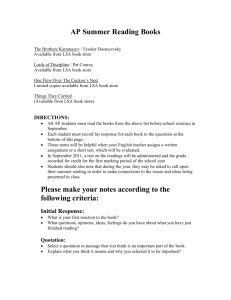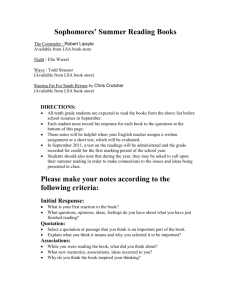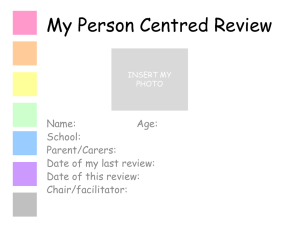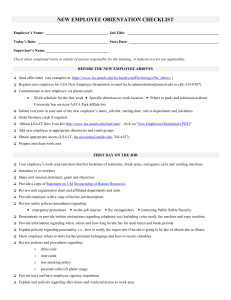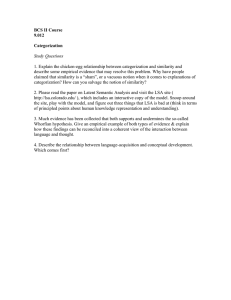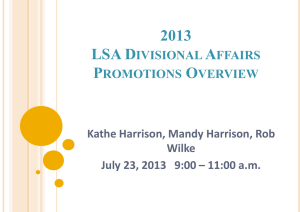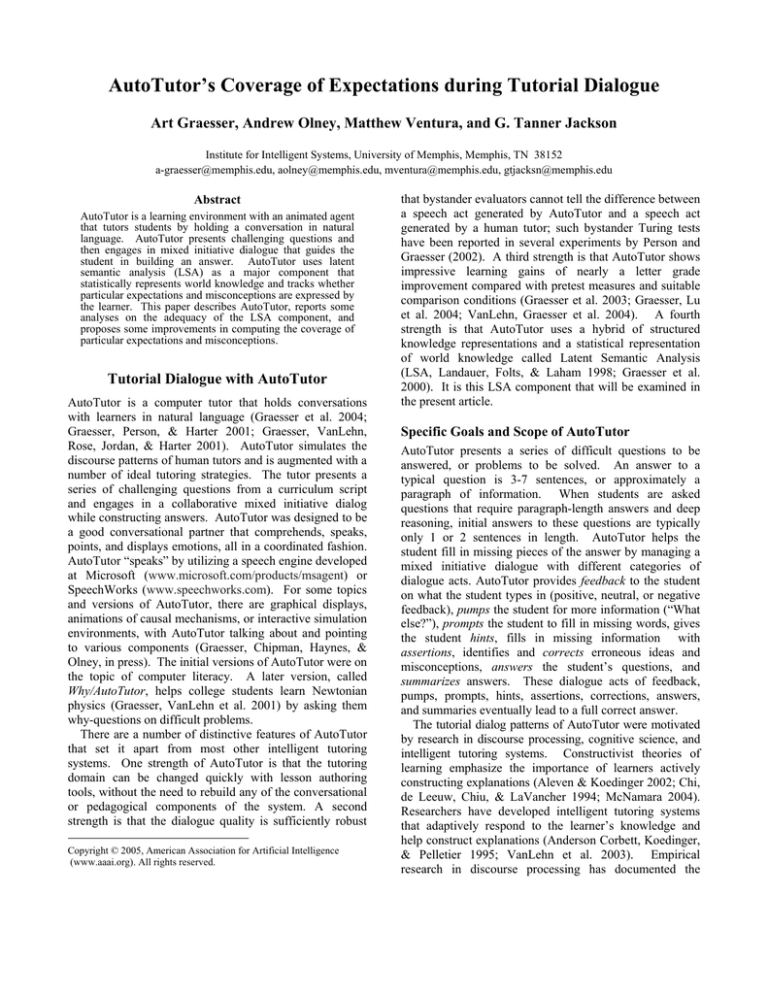
AutoTutor’s Coverage of Expectations during Tutorial Dialogue
Art Graesser, Andrew Olney, Matthew Ventura, and G. Tanner Jackson
Institute for Intelligent Systems, University of Memphis, Memphis, TN 38152
a-graesser@memphis.edu, aolney@memphis.edu, mventura@memphis.edu, gtjacksn@memphis.edu
Abstract
AutoTutor is a learning environment with an animated agent
that tutors students by holding a conversation in natural
language. AutoTutor presents challenging questions and
then engages in mixed initiative dialogue that guides the
student in building an answer. AutoTutor uses latent
semantic analysis (LSA) as a major component that
statistically represents world knowledge and tracks whether
particular expectations and misconceptions are expressed by
the learner. This paper describes AutoTutor, reports some
analyses on the adequacy of the LSA component, and
proposes some improvements in computing the coverage of
particular expectations and misconceptions.
Tutorial Dialogue with AutoTutor
AutoTutor is a computer tutor that holds conversations
with learners in natural language (Graesser et al. 2004;
Graesser, Person, & Harter 2001; Graesser, VanLehn,
Rose, Jordan, & Harter 2001). AutoTutor simulates the
discourse patterns of human tutors and is augmented with a
number of ideal tutoring strategies. The tutor presents a
series of challenging questions from a curriculum script
and engages in a collaborative mixed initiative dialog
while constructing answers. AutoTutor was designed to be
a good conversational partner that comprehends, speaks,
points, and displays emotions, all in a coordinated fashion.
AutoTutor “speaks” by utilizing a speech engine developed
at Microsoft (www.microsoft.com/products/msagent) or
SpeechWorks (www.speechworks.com). For some topics
and versions of AutoTutor, there are graphical displays,
animations of causal mechanisms, or interactive simulation
environments, with AutoTutor talking about and pointing
to various components (Graesser, Chipman, Haynes, &
Olney, in press). The initial versions of AutoTutor were on
the topic of computer literacy. A later version, called
Why/AutoTutor, helps college students learn Newtonian
physics (Graesser, VanLehn et al. 2001) by asking them
why-questions on difficult problems.
There are a number of distinctive features of AutoTutor
that set it apart from most other intelligent tutoring
systems. One strength of AutoTutor is that the tutoring
domain can be changed quickly with lesson authoring
tools, without the need to rebuild any of the conversational
or pedagogical components of the system. A second
strength is that the dialogue quality is sufficiently robust
Copyright © 2005, American Association for Artificial Intelligence
(www.aaai.org). All rights reserved.
that bystander evaluators cannot tell the difference between
a speech act generated by AutoTutor and a speech act
generated by a human tutor; such bystander Turing tests
have been reported in several experiments by Person and
Graesser (2002). A third strength is that AutoTutor shows
impressive learning gains of nearly a letter grade
improvement compared with pretest measures and suitable
comparison conditions (Graesser et al. 2003; Graesser, Lu
et al. 2004; VanLehn, Graesser et al. 2004). A fourth
strength is that AutoTutor uses a hybrid of structured
knowledge representations and a statistical representation
of world knowledge called Latent Semantic Analysis
(LSA, Landauer, Folts, & Laham 1998; Graesser et al.
2000). It is this LSA component that will be examined in
the present article.
Specific Goals and Scope of AutoTutor
AutoTutor presents a series of difficult questions to be
answered, or problems to be solved. An answer to a
typical question is 3-7 sentences, or approximately a
paragraph of information. When students are asked
questions that require paragraph-length answers and deep
reasoning, initial answers to these questions are typically
only 1 or 2 sentences in length. AutoTutor helps the
student fill in missing pieces of the answer by managing a
mixed initiative dialogue with different categories of
dialogue acts. AutoTutor provides feedback to the student
on what the student types in (positive, neutral, or negative
feedback), pumps the student for more information (“What
else?”), prompts the student to fill in missing words, gives
the student hints, fills in missing information with
assertions, identifies and corrects erroneous ideas and
misconceptions, answers the student’s questions, and
summarizes answers. These dialogue acts of feedback,
pumps, prompts, hints, assertions, corrections, answers,
and summaries eventually lead to a full correct answer.
The tutorial dialog patterns of AutoTutor were motivated
by research in discourse processing, cognitive science, and
intelligent tutoring systems. Constructivist theories of
learning emphasize the importance of learners actively
constructing explanations (Aleven & Koedinger 2002; Chi,
de Leeuw, Chiu, & LaVancher 1994; McNamara 2004).
Researchers have developed intelligent tutoring systems
that adaptively respond to the learner’s knowledge and
help construct explanations (Anderson Corbett, Koedinger,
& Pelletier 1995; VanLehn et al. 2003). Empirical
research in discourse processing has documented the
collaborative constructive activities that frequently occur
during human tutoring (Chi, Siler, Jeong, Yamauchi, &
Hausmann 2001; Fox 1993; Graesser, Person, & Magliano
1995).
Surprisingly, the dialog moves of most human tutors are
not particularly sophisticated from the standpoint of
today’s pedagogical theories and intelligent tutoring
systems. Human tutors rarely implement bona fide
Socratic tutoring strategies, modeling-scaffolding-fading,
reciprocal training, building on prerequisites, and other
sophisticated pedagogical techniques. Instead, human
tutors normally coach the student by filling in missing
pieces of information in an expected answer and by fixing
bugs and misconceptions expressed by the student. We
refer to this tutoring mechanism as Expectation and
Misconception Tailored Dialog. AutoTutor was designed
to simulate the dialog moves of human tutors who coach
students in constructing explanations and answers to openended questions.
A Concrete Example of AutoTutor
AutoTutor’s curriculum script consists of a set of questions
(or problems) and answers that require deep reasoning.
Listed below are the important forms of content affiliated
with each main question.
Main Question. If a lightweight car and a massive truck
have a head-on collision, upon which vehicle is the impact
force greater? Which vehicle undergoes the greater change
in its motion? Explain why.
Ideal Answer. The force of impact on each of the
colliding bodies is due to interaction between them. The
forces experienced by these bodies are thus an
action/reaction pair. Thus, in terms of Newton's third law
of motion, these forces will be equal in magnitude and
opposite in direction. The magnitude of the acceleration
produced by a force on different objects is inversely
proportional to their masses. Hence, the magnitude of the
car's acceleration due to the force of impact will be much
larger than that of the more massive truck. A larger
magnitude of acceleration implies a larger rate of change of
velocity, which may be interpreted as greater change in
motion. Therefore, the car undergoes greater change in its
motion.
Expectations.
(E1) The magnitudes of the forces exerted by the two
objects on each other are equal.
(E2) If one object exerts a force on a second object, then
the second object exerts a force on the first object in the
opposite direction.
(E3) The same force will produce a larger acceleration in a
less massive object than a more massive object.
Misconceptions.
(M1) A lighter/smaller object exerts no force on a
heavier/larger object.
(M2) A lighter/smaller object exerts less force on other
objects than a heavier/larger object.
(M3) The force acting on a body is dependent on the mass
of the body.
(M4) Heavier objects accelerate faster for the same force
than lighter objects.
(M5) Action and reaction forces do not have the same
magnitude.
Functionally Equivalent Concepts.
car, vehicle, object
truck, vehicle, object
The learner might possibly articulate the ideal answer to
this question, but such a complete answer rarely if ever
occurs.
Natural language is much too imprecise,
fragmentary, vague, ungrammatical, and elliptical to
anticipate such semantically well-formed and complete
responses. LSA is used to evaluate, probabilistically, the
extent to which the information within the student turns
(i.e., an individual turn, a combination of turns, or
collective sequence of turns) matches the ideal answer.
AutoTutor requires that the learner articulate each of the
expectations before it considers the question answered.
The system periodically identifies a missing expectation
during the course of the dialogue and posts the goal of
covering the expectation. When expectation E is missed
and therefore posted, AutoTutor attempts to get the student
to articulate it by generating hints and prompts that
encourage the learners to fill in missing content words and
propositions. Expectation E is considered covered if the
content of the learners’ turns meet or exceed a threshold T
in its LSA cosine value. More specifically, E is scored as
covered if the cosine match between E and the student
input I is high enough: cosine (E, I) ≥ T. The threshold has
varied between .40 and .75 in previous versions and
evaluations of AutoTutor.
Each expectation E has a family of prompts and hints
that potentially may be recruited in AutoTutor’s dialogue
acts in order to get the student to fill in every content word
and proposition in E. A particular prompt or hint from the
family is selected to maximize an increase in the LSA
cosine match score when the prompt or hint is expressed
by the learner. Students may express a misconception
during the dialogue. This happens when the student input I
matches a misconception M with a sufficiently high match
score. AutoTutor corrects the misconception and goes on.
AutoTutor systematically manages the dialogue when it
attempts to get the learner to articulate an expectation E
that gets posted. AutoTutor stays on topic by completing
the sub-dialog that covers expectation E before starting a
sub-dialog on another expectation. Learners often leave out
a content word, phrase, or entire clause within E. As
already mentioned, specific prompts and hints are selected
that maximize the learner’s filling in this content and
boosting the match score above threshold. Suppose, for
example, that expectation E1 needs to be articulated in the
answer. The following family of candidate prompts is
available for selection by AutoTutor to encourage the
student to articulate particular content words in expectation
E1.
(a) The magnitudes of the forces exerted by two
objects on each other are ____.
(b) The magnitudes of forces are equal for the two
______.
(c) The two vehicles exert on each other an equal
magnitude of _____.
(d) The force of the two vehicles on each other are
equal in _____.
If the student fails to articulate one of the four content
words (equal, objects, force, magnitude), then AutoTutor
selects the corresponding prompt (a, b, c, and d,
respectively).
LSA plays a critical role in AutoTutor in several
respects. LSA serves as a conceptual pattern matcher as it
constantly is comparing learner input to expectations and
misconceptions. It provides a quantitative metric for
evaluating the extent to which any two bags of words meet
or exceed a threshold criterion. LSA is a statistical metric
for performing pattern recognition, pattern matching, and
pattern completion operations. The fidelity of the LSA
component needs to be carefully evaluated in light of its
central role in AutoTutor.
LSA-based Metrics that Evaluate the
Coverage of Expectations and Misconceptions
This section reports some of the analyses that we have
conducted in our evaluations of the extent to which LSA
accurately assesses coverage of expectations and
misconceptions. We have considered different units of
analysis, spans of text, and algorithms in these
assessments. These assessments of LSA have been
conducted on the topics of computer science (Graesser,
P.Wiemer-Hastings, K. Wiemer-Hastings, Person, &
Harter 2000; P. Wiemer-Hastings, K. Wiemer-Hastings, &
Graesser 1999) and Newtonian physics (Olde, Karnavat,
Franceschetti, & Graesser 2002).
An LSA space requires a corpus of training texts, so a
few words should be said about the corpora we used for
AutoTutor. The versions of AutoTutor for computer
literacy covered the topics of hardware, operating systems,
and the Internet. The corpus consisted of a textbook on
computer literacy, the curriculum script, and 30 articles,
namely 10 for each of the three topics. The version of
AutoTutor for physics consisted of the curriculum script, a
textbook written by Hewitt (1998), and 10 articles on
Newtonian physics. We used 300 dimensions in the LSA
space for all of these tutors. It should be noted that the
performance of LSA did not improve much when we
sanitized the corpus by including only relevant documents
and content (Olde et al. 2002), but we would expect
performance to noticeably improve with a corpus that is 34 times the current size.
Evaluating Answer Essays
One of the performance assessments of AutoTutor is an
essay test that is administered before and after AutoTutor
training.
The essays consist of students answering
qualitative physics questions on their own, without any
assistance. The major research question is how well LSA
fares in grading these essays. Automated essay graders
have adopted LSA metrics (Foltz, Gilliam, & Kendall
2000), so we pursued a similar assessment for AutoTutor.
The standard approach is to compare LSA-based grades of
essays with essay quality ratings of subject matter experts.
We have we asked experts in physics or computer
literacy to make judgments about the overall quality of the
student essays.
An expert’s quality rating was
operationally defined as the proportion of expectations in
an essay that judges believed were covered (using criteria
that vary from stringent to lenient). Similarly, LSA was
used to compute the proportion of expectations covered,
using varying thresholds of match scores on whether
information in the student essay covered each expectation.
Correlations between the LSA scores and the judges’
quality ratings (i.e., the mean rating across judges) were
approximately .50 for both conceptual physics (Olde et al.
2002) and computer literacy (Graesser et al. 2000; P.
Wiemer-Hastings et al. 1999). Correlations have generally
increased as the length of the text increases, yielding
correlations of .73 or higher in other laboratories (Foltz et
al. 2000). We believe that our LSA-based assessments
would exceed the .50 correlation if the answers had more
words and the corpus was much larger. It is informative to
note that the correlations between a pair of experts in our
studies was approximately .65, so LSA agrees with experts
approximately as good as experts agree with each other.
User Modeling During AutoTutor Training
As students contribute information, turn by turn, their
content is compared with the expectations and
misconceptions in the curriculum script. How well does
LSA perform this user modeling? We have performed
some analyses on the LSA cosine scores in AutoTutor’s
log files in order to answer this question.
In one analysis of conceptual physics, pretest scores on a
multiple choice test served as the gold standard of the
students’ pre-experimental knowledge of physics before
they started the AutoTutor training. The multiple choice
test was similar to a frequently used test developed by
Coverage Characteristics Curves. A different approach
to assessing user modeling is by analyzing the evolution of
answers to the main questions. As the student contributes
information, turn, by turn, the LSA coverage scores should
increase. Coverage characteristics curves (CC-curves)
were prepared in order to assess whether this is the case. A
CC-curve is the LSA score for an expectation E plotted as
a function of conversational turns or as a function of
particular states in the evolution of the answer. For
example, Graesser et al. (2000) reported CC-curves for
computer literacy by plotting mean cumulative LSA cosine
scores for each expectation as a function of conversational
turns. The scores were cumulative in the sense that the
student’s content in turn N+1 includes all of the content
articulated by the student in turns 1 through N. The mean
LSA scores were .27, .39, .45, .62, .66, and .76 for turns 1,
2, 3, 4, 5, and 6, respectively. These data support the claim
that LSA adequately tracks the evolving evolution of a
correct answer over conversational turns.
We prepared some CC-curves for one of our recent
experiments on physics. We identified the total set of
dialogue sequences in which the student had trouble
articulating a particular expectation E. The LSA coverage
score for E was recorded at 5 points: (a) after the question
was first asked and AutoTutor pumped the student for
information for one turn, (b) a first hint was given, (c) a
first prompt was given (always after a first hint), (d) a
second hint was given, and (e) a second prompt was given
(always after the second hint). Figure 1 plots the mean
LSA scores as a function of these five states in the
dialogue history for an expectation E. As can be seen in
Figure 1, there is a monotonic increase in LSA values over
turns. The values are also higher for students with high
than low pre-experimental knowledge about physics.
Therefore, AutoTutor’s LSA component provides a valid
metric for tracking the coverage of an expectation over the
tutorial dialogue.
Figure 1. Relationship between LSA cosine and number of
student contributions in AutoTutor’s physics tutor.
0.7
0.6
LSA cosine
Hestenes, Wells, and Swackhamer (1992), called the Force
Concept Inventory. If AutoTutor is performing effective
user modeling, then the dialogue moves selected by
AutoTutor should be systematically affected by the
students’ prior knowledge of physics. This indeed was the
case when we analyzed the dialogue moves (Jackson,
Mathews, Lin, & Graesser 2004).
Consider first the short feedback that AutoTutor gives to
the student after most of the student’s turns. The students’
physics knowledge has a significant positive correlation
with proportion of short feedbacks that were positive and a
negative correlation with negative feedback. Next consider
the corrections that AutoTutor made when identifying
student errors and misconceptions. There was a negative
correlation between student knowledge and the number of
misconceptions identified by AutoTutor. Consider finally
the three dialogue move categories that attempt to cover
the content of the expectations in the curriculum script:
Hints, prompts, and assertions. There is a continuum from
the student supplying information to the tutor supplying
information as we move from hints, to prompts, to
assertions. The correlations with student knowledge
reflected this continuum perfectly, with correlations being
positive for hints and negative for assertions. For students
with more knowledge of physics, all AutoTutor needs to do
is pump and hint, thereby nudging the student to articulate
the expectations. For students with less knowledge of
physics, AutoTutor needs to generate prompts for specific
words or to assert the correct information, thereby
extracting knowledge piecemeal or telling the student the
correct information. These results support the claim that
AutoTutor performs user modeling with some modicum of
accuracy; the system adaptively responds to the learner’s
level of knowledge.
0.5
0.4
0.3
0.2
Tur n 1
Hint - 1
P r ompt - 1
Hint - 2
P r ompt - 2
Hi gh k n owl e dge stu de n t
Low k n owl e dge stu de n t
Matching Sentential Expectations to Learners’
Sentential Contributions. An expert physicist rated the
degree to which particular speech acts expressed during
AutoTutor training matched particular expectations. These
judgments were made on a sample of 25 physics
expectations (sentence-length units, such as E1 through
E5) and 5 randomly sampled student turns per expectation,
yielding a total of 125 pairs of expressions. The learner
turns were always responses to the first hint for that
expectation. The question is how well the expert ratings
correlate with LSA coverage scores.
The correlation between an expert judge’s rating and the
LSA cosine was modest, only r = .29. We scaled the 125
items on two other scales, to see how they would compare
with LSA. First, we computed overlap scores between the
words in the two sentential units (minus a, an, the). If an
expectation has A content words, a student speech act has
B content words, and there are C common words between
the two sentential units, then the overlap score is computed
as [2C/(A+B)]. The correlation between expert ratings and
word overlap scores was r = .39. So a simple word overlap
metric does a somewhat better job than LSA per se when
sentential units are compared. Second, we scaled whether
the serial order of common content words was similar
between the two sentential units by computing Kendall’s
Tau scores. This word-order similarity metric had a .25
correlation with the expert ratings. We performed a
multiple regression analysis that assessed whether the
expert ratings could be predicted by LSA, word overlap,
and Kendall’s Tau together.
The three predictors
accounted for a significant r = .42. These results support
the conclusion that analyses of sentences would benefit
from a hybrid computational algorithm that considers both
LSA and alternative algorithms. Alternative algorithms
would consider (a) associates of the content words
computed as nearest neighbors in the LSA space (Kintsch
2001), (b) word combinations in the actual corpus (Ventura
et al. 2004), and (c) word sequences. A hybrid model
between LSA and symbolic models of syntax and meaning
would be a sensible research direction.
What Expectations are LSA-worthy?
It is conceivable that some expectations are more amenable
to LSA computations than others.
For example,
expectations that have high frequency words should have
poorer performance because there would not be enough
distinctive content. Ideally, AutoTutor would have a
principled way of determining whether or not an
expectation is LSA-worthy. An expectation is defined as
LSA-worthy if there is a high correlation between LSA and
human experts in its being covered in essays or the training
history. If AutoTutor could predict the LSA worthiness of
an expectation in a principled way, then that could guide
whether it trusted the LSA metrics. LSA metrics would be
used for expectations that are LSA-worthy, but other
algorithms would be used for expectations that are not
LSA-worthy.
We computed LSA-worthiness scores for approximately
40 expectations associated with the physics problems that
were used in the pretest and posttest essays. The LSA
worthiness score for expectation E is simply a correlation
between (a) the LSA coverage scores for E on a sample of
essays and (b) the mean expectation coverage rating among
5 expert judges. These judges score whether any given
expectation E was present in a particular essay in the
sample. The correlation score between (a) and (b) should
approach 1.0 to the extent an expectation is LSA-worthy.
Some examples of these scores are listed for 4 of the
expectations.
After the release, the only force on the balls is the force
of the moon’s gravity (r = .71)
A larger object will experience a smaller acceleration
for the same force (r = .12)
Force equals mass times acceleration (r = .67)
The boxes are in free fall (r = .21)
The first and third of these expectations would be
considered LSA-worthy, but not the second and fourth. It
is fortunate that the third expectation is LSA-worthy
because it captures Newton’s second law.
We performed some analyses that assessed whether
there were linguistic or conceptual properties of the
expectations that would correlate with the LSA-worthiness
scores. If there are, we would have a principled way for
AutoTutor to gauge whether the LSA assessments can be
trusted. We have examined dozens of linguistic and
conceptual properties of the expectations, but only two of
them significantly correlated with LSA-worthiness:
Number of infrequent words (r = .23) and negations (r = .29). Among the other properties that had near-zero
correlations were number of words, content words,
glossary terms, relative terms (e.g., small, fast), quantifiers
(e.g., some, all, one, two), deictic expressions (e.g., this,
that), and vector length. These modest correlations suggest
it may be difficult to predict a priori which of the
expectations will end up being LSA-worthy.
Conclusions about LSA
We are convinced that LSA has been moderately
successful as a foundational representational system for
AutoTutor. It was capable of grading essays in physics
and computer literacy (r = .5), almost as well as experts. It
could significantly perform user modeling and track the
coverage of expectations during the evolution of
collaborative dialogue. Sentence unit matches with LSA
are limited (r = .3), however, so it is important to consider
explicit word overlap and ordering of words when
sentential units are compared. We know that some
expectations can be reliably computed with LSA, but
others cannot be and will require more hybrid architectures
for conceptual pattern matching. We will explore some
theoretically principled hybrid models in our quest for an
adequate sentential pattern matcher.
Acknowledgements
The Tutoring Research Group (TRG) is an
interdisciplinary
research
team
comprised
of
approximately 35 researchers from psychology, computer
science,
physics,
and
education
(visit
http://www.autotutor.org). The research on AutoTutor was
supported by the National Science Foundation and the
Department of Defense Multidisciplinary University
Research Initiative administered by the Office of Naval
Research. Any opinions, findings, and conclusions or
recommendations expressed in this material are those of
the authors and do not necessarily reflect the views of
DoD, ONR, or NSF.
References
Aleven, V., & Koedinger, K. R. 2002. An effective
metacognitive strategy: Learning by doing and explaining
with a computer-based Cognitive Tutor. Cognitive Science
26:147-179.
Anderson, J. R., Corbett, A. T., Koedinger, K. R., &
Pelletier, R. 1995. Cognitive tutors: Lessons learned. The
Journal of the Learning Sciences 4:167-207.
Chi, M.T.H., de Leeuw, N., Chiu, M. & LaVancher, C.
1994. Eliciting self-explanation improves understanding.
Cognitive Science 18:439-477.
Chi, M. T. H., Siler, S., Jeong, H., Yamauchi, T., &
Hausmann, R. G. 2001. Learning from human tutoring.
Cognitive Science 25:471-533.
Foltz, P.W., Gilliam, S., & Kendall, S. 2000. Supporting
content-based feedback in on-line writing evaluation with
LSA. Interactive Learning Environments 8:111-127.
Fox, B. 1993. The human tutorial dialog project.
Hillsdale, NJ: Erlbaum.
Graesser, A.C., Chipman, P., Haynes, B.C., & Olney, A.
2004. AutoTutor: An intelligent tutoring system with
mixed-initiative dialogue.
Submitted to IEEE
Transactions on Learning.
Graesser, A.C., Hu, X., Person, P., Jackson, T., and Toth, J
2004. Modules and information retrieval facilities of the
Human Use Regulatory Affairs Advisor (HURAA).
International Journal on eLearning. Forthcoming.
Graesser, A.C., Lu, S., Jackson, G.T., Mitchell, H.,
Ventura, M., Olney, A., & Louwerse, M.M. 2004.
AutoTutor: A tutor with dialogue in natural language.
Behavioral Research Methods, Instruments, and
Computers. Forthcoming.
Graesser, A.C., Person, N., Harter, D., & the TRG 2001.
Teaching tactics and dialog in AutoTutor. International
Journal of Artificial Intelligence in Education 12:257-279.
Graesser, A. C., Person, N. K., & Magliano, J. P. 1995.
Collaborative dialogue patterns in naturalistic one-to-one
tutoring. Applied Cognitive Psychology 9:1-28.
Graesser, A.C., VanLehn, K., Rose, C., Jordan, P., &
Harter, D. 2001.
Intelligent tutoring systems with
conversational dialogue. AI Magazine 22(3):39-51.
Graesser, A.C., Wiemer-Hastings, K., Wiemer-Hastings,
P., Kreuz, R., & the TRG 1999. Auto Tutor: A simulation
of a human tutor. Journal of Cognitive Systems Research
1:35-51.
Graesser, A.C., Wiemer-Hastings, P., Wiemer-Hastings,
K., Harter, D., Person, N., and the TRG 2000. Using latent
semantic analysis to evaluate the contributions of students
in AutoTutor. Interactive Learning Environments 8:129148.
Hestenes, D., Wells, M., & Swackhamer, G. 1992. Force
Concept Inventory. The Physics Teacher 30:141-158.
Hewitt, P. G. 1987. Conceptual Physics. Menlo Park, CA:
Addison-Wesley.
Hume, G. D., Michael, J.A., Rovick, A., & Evens, M. W.
1996. Hinting as a tactic in one-on-one tutoring. The
Journal of the Learning Sciences 5:23-47.
Jackson, G.T., Mathews, E.C., Lin, D., Graesser, A.C.
2003. Modeling student performance to enhance the
pedagogy of AutoTutor. In P. Brusilovsky, A. Corbett, and
F. de Rosis (Eds.), Lecture Notes in Artificial Intelligence:
2702, 368-372. New York: Springer.
Jurafsky, D., & Martin, J.H. 2000. Speech and language
processing: An introduction to natural language
processing, computational linguistics, and speech
recognition. Upper Saddle River, NJ: Prentice-Hall.
Kintsch, W. 2001. Predication. Cognitive Science 25:173202.
Landauer, T.K., & Dumais, S.T. 1997. A solution to
Plato’s problem: The Latent Semantic Analysis theory of
the acquisition, induction, and representation of
knowledge. Psychological Review 104:211-240.
Landauer, T.K., Foltz, P.W., Laham, D. 1998. An
introduction to latent semantic analysis.
Discourse
Processes 25:259-284.
McNamara, D.S. 2004. SERT: Self-explanation reading
training. Discourse Processes 38:1-30.
Olde, B. A., Franceschetti, D.R., Karnavat, Graesser, A. C.
& the TRG 2002. The right stuff: Do you need to sanitize
your corpus when using latent semantic analysis? In W.
Gray and C. Schunn Eds.), Proceedings of the 24th Annual
Conference of the Cognitive Science Society, 708-713.
Mahwah, NJ: Erlbaum.
Penumatsa, P., Ventura, M., Graesser, A.C., Franceschetti,
D.R., Louwerse, M., Hu, X., Cai, Z., & the TRG 2004.
The right threshold value: What is the right threshold of
cosine measure when using latent semantic analysis for
evaluating student answers? International Journal of
Artificial Intelligence Tools. Forthcoming.
Person, N. K., Graesser, A. C., & the TRG 2002. Human
or computer? AutoTutor in a bystander Turing test. In S.
A. Cerri, G. Gouarderes, & F. Paraguacu (Eds.),
Proceedings of the Sixth International Conference on
Intelligent Tutoring Systems, 821-830. Berlin: Springer.
VanLehn, K., Graesser, A.C., Jackson, G.T., Jordan, P.,
Olney, A., & Rosé, C.P. 2004. Natural language tutoring:
A comparison of human tutors, computer tutors and text.
Submitted to Cognitive Science.
VanLehn, K., Jordan, P., Rosé, C. P., Bhembe, D., Bottner,
M., Gaydos, A., et al. 2002. The architecture of Why2Atlas: A coach for qualitative physics essay writing. In
S.A. Cerri, G. Gouarderes, & F. Paraguacu (Eds.),
Proceedings of the Sixth International Conference on
Intelligent Tutoring, 158-167. Berlin: Springer – Verlag.
Ventura, M., Hu, X., Graesser, A., Louwerse, M., & Olney,
A. 2004. The context dependent sentence abstraction
model. In K. D. Forbus, D. Gentner, & T. Regier (Eds.),
Proceedings of the 26rd Annual Meeting of the Cognitive
Science Society. Mahwah, NJ: Erlbaum. Forthcoming.
Wiemer-Hastings, P., Wiemer-Hastings, K., and Graesser,
A. 1999. Improving an intelligent tutor's comprehension of
students with Latent Semantic Analysis. In S.P. Lajoie and
M. Vivet, Artificial Intelligence in Education, 535-542.
Amsterdam: IOS Press.

